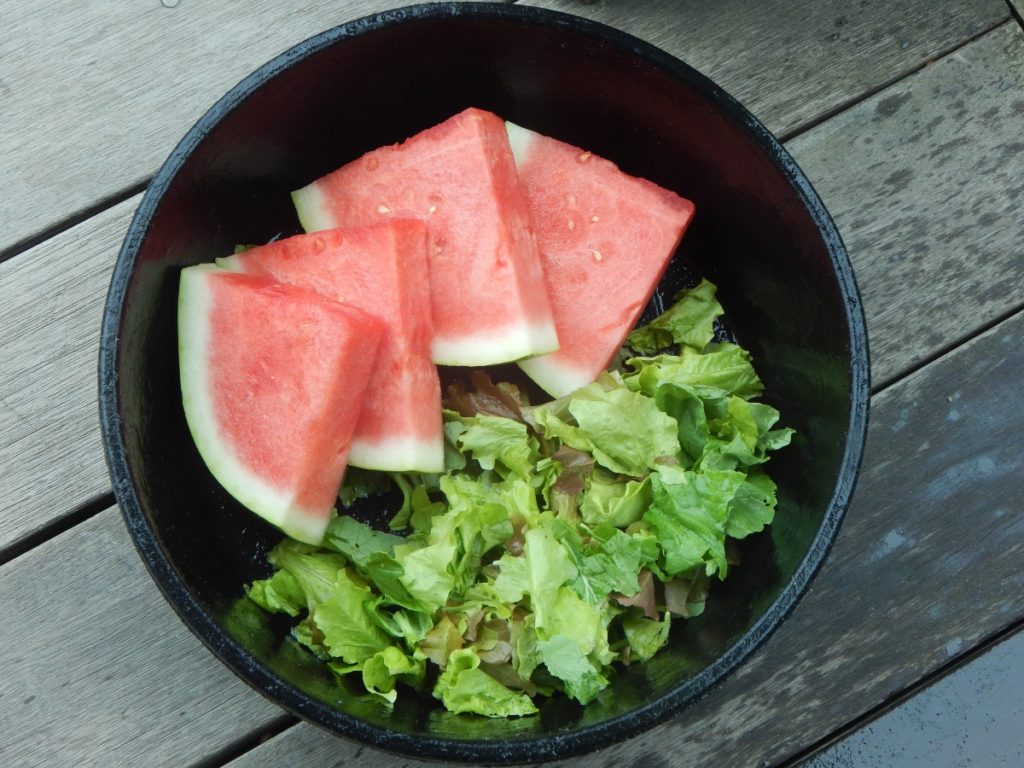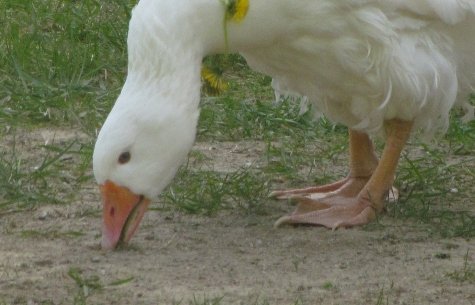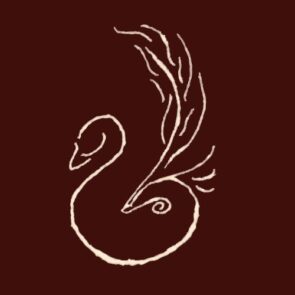My feeding regimen for my geese has been evolving since the first two arrived as day-olds in the mail almost six years ago, and I’m still learning and experimenting! Probably the most important thing I have learned about feeding geese is that adjustments are necessary for different stages and seasons. It’s not weird that I’m often recalculating what I feed my geese, and how I go about feeding it to them. The only thing I need to remember in the midst of the recalculating is to transition slowly between major diet changes — something I’m apt to forget.
What’s Good for the Goose…
Pasture –
Grass is the staple food of geese. I remember being amazed at this in my early stages of goose research. Despite being birds, geese are grazers. In my experience, they are picky, though. There have been times when I have taken them for a walk around our property to look for some grass, because they didn’t have much in their yard. (I am currently working on pasture improvement.) And what did they do when we arrived at some lovely greenery? Hunt with their beaks to the ground for worms or favorite plants — like dandelions — and basically ignore the grass.
Even though they are a bit picky, they do need the best grass I can give them — and plenty of it.
And that brings up the problem of winter.
Hay –
I live in Vermont, so the grass growing season is short. And there are a few months when the nearest grass is often buried under a couple feet of snow.
Enter: the quality grass hay bale.
I didn’t try this until my second winter of goose-keeping. The first winter, I had the goose “tractor” up on straw bales, and I noticed that the geese pulled out a ton of the straw and munched on it. The next year I bought them some second-cut hay — just two or three bales. I was amazed at how much they seemed to appreciate it.
Since then, I’ve kept a few hay bales around to feed to them whenever they don’t have enough grass available. I keep a pair of scissors in the barn and chop the hay into 3 – 6 inch lengths to prevent them from getting impacted gizzards.
I have no idea what the nutrition value is like for them, but at least it provides fiber to go with their winter grain diet. And it keeps them busy with “grass” to munch on.
Grains –
My geese get a mixture of whole wheat berries and whole oats mixed roughly 4:1. I feed them this even in the summer to make sure that they are getting what they need. I feed this mixture free-choice and dry in a container attached to the wall. My books recommend feeding whole grain by dropping it in the water bucket. I tried that for most of that first winter, but I didn’t portion it out well and found that I wasted a ton of it. The dry method has worked better for me — at least until until this week.
I saw a little chipping sparrow flying onto the “porch” of the goose shed a couple days ago. I’m not sure if it was after the grain or some bits of hay for its nest. Either way, I may have to rethink dry-feeding the grain, at least for the summer.
Even though I generally give them their grain dry, I do my best to make sure it’s not too far from their water bucket. This keeps them from choking when they eat.
Breeding Season Adjustments —
Beginning around January first, I add 20% protein turkey grower/finisher pellets (The main ingredient is corn, which some goose keepers object to.) to the whole grains mix until I have a mixture that’s roughly 18% protein. I feed this free-choice through the laying season.
Once the geese are done laying eggs, I usually begin transitioning them off the pellets (or at least less of the pellets to lower the overall protein content). But it can take a while, since there is still not much grass in Vermont in March and April, and if a goose has been sitting, she’s lost a lot of weight.
My books recommend feeding whole grains to a setting goose, so this spring I planned to stop feeding the pellets as soon as my geese decided to go broody. (They insist on doing this, regardless of whether they have a mate.) But one of my geese had finished laying and was sitting faithfully on her dummy eggs, while the other was still laying. So I separated the whole grain from the pellets so that the geese could individually take what they wanted. My hope is that they will know better than I do what they need.
Feeding Corn —
Also, during the winter, I do sometimes feed them cracked corn for energy. Now, some people feel that corn is always a total no-no. You may want to do some research and make your own call on whether to feed your geese corn, and how much. I tend to feed the corn in small amounts on extremely cold mornings, or as a last feeding on single-digit or sub-zero nights. My older goose, Jena, especially loves it. She would definitely get fat on it if I didn’t limit it.
Treats –

If only I loved healthy treats as much as my geese do! 😊 I read about other people’s geese eating this or that veggie, and I read recommendations on veggies to grow for geese, and I sigh. Mine seem kinda picky. They love three things and don’t seem to care a whole lot for much else:
Watermelon –
I usually chop it up in chunks for them and give them some bits of rind too. But sometimes I just slice it and let them chew it. Most of the time they go nuts for this, but even watermelon gets ignored on occasion.
Lettuce –
On a snowy morning, their excitement is deafening if I show up with a tub of chopped lettuce. Generally, I rinse it and tear it up for them, just because I’m particular. I usually buy leaf lettuce, and I have bought Iceburg in the past. But a note in Lisa Steele’s book Duck Eggs Daily stating that it “can cause diarrhea”* made me rethink that. If it’s not good for ducks, it’s probably not great for geese either.
Dandelions –
This is their absolute favorite food. They will hunt dandelions out of a patch of grass, and they get so ecstatic when they see someone approaching their fence with a handful of dandelions. Most of the time, they don’t seem to eat the flowers. But they will devour the greens and even eat some of the root.
Supplements –
Grit –

This is absolutely necessary during the winter, when my geese can’t dig up and eat the dirt and sand and little stones that enables their gizzard to grind up their food. I offer this to my geese free-choice all year just to be on the safe side, but they definitely eat more of it in the winter.
Oyster Shell/Eggshells –
I feed this only during laying season, free-choice, and the females eat as much of it as they want as a calcium supplement. This is also a necessity, since I am not feeding them laying pellets. Feeding the calcium supplement separately helps me avoid giving my geese a calcium overdose. This was especially important when I had a gander who needed the high-protein breeder’s diet, but didn’t need any extra calcium, of course.
Dave Holderread, in his The Book of Geese, recommends 2.25 — 2.75 percent calcium for breeding geese**, and I have an old nutrition fact sheet off a bag of laying pellets that lists calcium at 3.55 percent!
I have always bought oyster shells specifically for poultry at my local feed store, but I recently tried feeding my geese some of their own eggshells. The membranes on the inside of the shell peel off fairly easily. I baked mine, (on a cookie sheet at 300 degrees Fahrenheit for 10 minutes.) but other people air dry theirs or don’t dry them at all. Here is a great article I found on feeding eggshells to poultry for calcium. You can get inventive with how you crush them. I put mine in a cereal bowl and crushed them with the back of a medium-sized soup ladle. My goose scarfed them down without a problem.
Recalculating…
My goose-feeding regimen is in a state of perpetual adjustment, but this is where I’m at for now. Meanwhile, in addition to the more tried-and-true feed stuffs, I’m hoping to try growing a watermelon-and-lettuce garden for my two silly, adorable, persnickety geese. And maybe I’ll try to expand their range of tastes a little….
If you keep geese, what are their favorite treats? Let me know in the comments below!
______________________________________________________________________________________________* Lisa Steele, Duck Eggs Daily: Raising Happy, Healthy Ducks…Naturally (Pittsburgh: St. Lynn’s Press, 2015), 68
** Dave Holderread, The Book of Geese: A Complete Guide to Raising the Home Flock (Corvallis: Hen House Publications, 1993), 106
